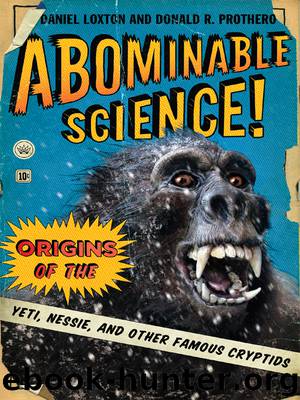Origins of the Yeti, Nessie, and Other Famous Cryptids by Daniel Loxton

Author:Daniel Loxton
Language: eng
Format: epub
Tags: SCI019000, Science/Earth Sciences/General, SCI054000, Science/Paleontology
Publisher: Columbia University Press
Published: 2013-08-05T16:00:00+00:00
Figure 5.24 The creature reported by officers of the HMS Daedalus in 1848.
The Daedalus case became an enduring part of the cryptozoological canon after it attracted a detailed public critique from one of the world’s weightiest scientific authorities: Richard Owen, of the British Museum, who had coined the term “dinosaur” just six years earlier. Owen’s reputation in his field was overpowering (“[H]is opinion on a zoological question has almost the force of an axiom,” as one of his contemporaries put it),120 although he was known personally as an unpleasant character. His unrelenting campaign against Darwinian evolution and its supporters, which included a venomous anonymous review of On the Origin of Species,121 led the normally genial Darwin to admit, “I used to be ashamed of hating him so much, but now I will carefully cherish my hatred & contempt to the last days of my life.”122 Nonetheless, Owen was an awfully sharp guy, and his critique of the Daedalus case stands as one of the clearest skeptical statements on sea serpent mythology. Owen argued, plausibly enough, that M’Quhae may have misidentified an elephant seal or a sea lion. These massive mammals would match fairly closely with M’Quhae’s description of the sea serpent and the drawings he endorsed, but it remains a purely speculative explanation—parsimonious, but unproved. And that is where the mystery remains: a deadlock between Owen’s argument that M’Quhae did not know what he was looking at and M’Quhae’s retort that Owen did not know what he was talking about: “I now assert—neither was it a common seal nor a sea-elephant, its great length and its totally differing physiognomy precluding the possibility.”123
Owen knew that his elephant seal explanation was speculative, but he was sure about one thing: there was no way a living plesiosaur had casually glided past a Royal Navy frigate. His caustic response remains relevant to cryptozoology:
Now, on weighing the question, whether creatures meriting the name of “great sea-serpent” do exist, or whether any of the gigantic marine saurians of the secondary deposits may have continued to live up to the present time, it seems to me less probable that no part of the carcass of such reptiles should have ever been discovered in a recent or unfossilized state, than that men should have been deceived by a cursory view of a partly submerged and rapidly moving animal, which might only be strange to themselves. In other words, I regard the negative evidence, from the utter absence of any of the recent remains of great sea-serpents, krakens, or Enaliosauria, as stronger against their actual existence than the positive statements which have hitherto weighed with the public mind in favor of their existence. A larger body of evidence, from eye-witnesses, might be got together in proof of ghosts than of the sea-serpent.124
Other scientific superstars were more easily seduced by the possibility of surviving plesiosaurs, including the great geologist and paleontologist Louis Agassiz of Harvard University. Agassiz’s scientific legacy includes the distinction of being among the first to propose a “glacial” period (ice age) in Earth’s history.
Download
This site does not store any files on its server. We only index and link to content provided by other sites. Please contact the content providers to delete copyright contents if any and email us, we'll remove relevant links or contents immediately.
| Anatomy | Animals |
| Bacteriology | Biochemistry |
| Bioelectricity | Bioinformatics |
| Biology | Biophysics |
| Biotechnology | Botany |
| Ecology | Genetics |
| Paleontology | Plants |
| Taxonomic Classification | Zoology |
Sapiens: A Brief History of Humankind by Yuval Noah Harari(13126)
The Tidewater Tales by John Barth(12047)
Do No Harm Stories of Life, Death and Brain Surgery by Henry Marsh(6350)
Mastermind: How to Think Like Sherlock Holmes by Maria Konnikova(6276)
The Thirst by Nesbo Jo(5821)
Why We Sleep: Unlocking the Power of Sleep and Dreams by Matthew Walker(5680)
Sapiens by Yuval Noah Harari(4579)
Life 3.0: Being Human in the Age of Artificial Intelligence by Tegmark Max(4542)
The Longevity Diet by Valter Longo(4467)
The Rules Do Not Apply by Ariel Levy(3939)
The Body: A Guide for Occupants by Bill Bryson(3863)
The Immortal Life of Henrietta Lacks by Rebecca Skloot(3843)
Why We Sleep by Matthew Walker(3798)
Animal Frequency by Melissa Alvarez(3772)
Yoga Anatomy by Kaminoff Leslie(3726)
Barron's AP Biology by Goldberg M.S. Deborah T(3646)
The Hacking of the American Mind by Robert H. Lustig(3602)
All Creatures Great and Small by James Herriot(3543)
Yoga Anatomy by Leslie Kaminoff & Amy Matthews(3421)
